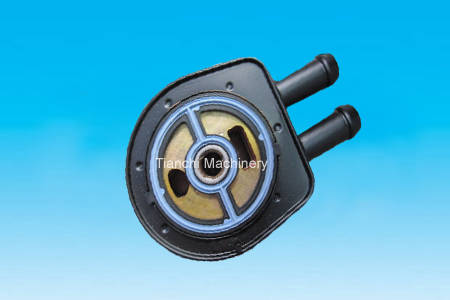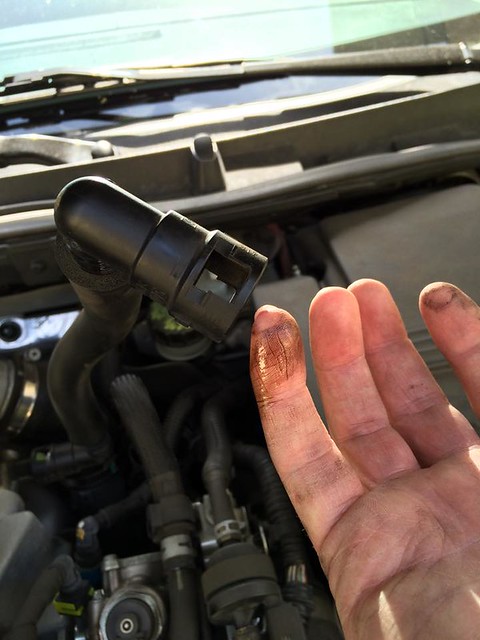Update at 45K:
MSCAI Filter
Mazda recommends cleaning the filter every 20K so I took a couple hours off to get it done. First thought? A 2nd filter would be REALLY convenient lol. Most filters - even CAI ones - are pretty easy to access once installed. Mazda's version is a bit more challenging due to the splash shield. On a lowered car you're required to jack it up, remove the driver's side wheel/splash shields, and remove the MSCAI filter/splash shield assembly. Not to hard but certainly more work than a short ram. What's worse is that the filter takes a good 24-48 hours to dry depending on the weather. Here are a few pics of the process (for those who don't have the MSCAI):
- Filter cleaning kit (two bottles). Exact same contents as the AEM version, part #21-110.
http://carphotos.cardomain.com/ride_images/1/1259/1349/3145674026_large.jpg
- Few shots of the filter removed. The lower splash shields need to be removed in order to access the filter assembly. On lowered cars, it's recommended you remove the driver's side front wheel for easier access.
http://carphotos.cardomain.com/ride_images/1/1259/1349/3145674027_large.jpg
http://carphotos.cardomain.com/ride_images/1/1259/1349/3145674023_large.jpg
- The filter splash shield bolts directly to the intake piping. So removing the bolts first will allow you to disconnect and pull the assembly out from under. As you can see, the filter is impossible to remove without first unbolting the splash shield.
http://carphotos.cardomain.com/ride_images/1/1259/1349/3145674028_large.jpg
http://carphotos.cardomain.com/ride_images/1/1259/1349/3145674021_large.jpg
http://carphotos.cardomain.com/ride_images/1/1259/1349/3145674019_large.jpg
- Cleaning the filter requires both bottles to be used. Empty one into a bucket of warm water and rotate the filter back and forth a few minutes to agitate the dirt. DO NOT allow the water to enter the neck or dirt released from the outer layer of the filter will adhere to the inner assembly and eventually soil the MAF. Remove the filter, tap off excess water, dump the bucket and repeat the process again.
http://carphotos.cardomain.com/ride_images/1/1259/1349/3145674020_large.jpg
So how was the end result? Nearly disastrous. Took the car on a test drive after letting the filter air dry for 24 hours. Damn thing bogged violently on anything but a light tap on the throttle. Turns out the interior of the filter assembly was still slightly damp and interfering with the MAF under load. After letting the filter dry another 24 hours all was good. Inspected the MAF for any residue or dirt. Nothing. Could have easily been a $200 mistake.
CPE RMM Update/Corksport Inserts
As I mentioned previously the CPE 75 duro RMM wasn't quite working out. After a good 1K of constant driving with the HVAC on it was time for a change. Ended up doing a trade + cash with a member who had been running Corksport Inserts for 40K. The results were pleasantly surprising.
Many people on the boards claim the inserts wear out after several thousand miles. I can tell you first hand that's NOT the case - at least compared to stock that is. The inserts, despite having some hard miles on them, made a noticeable difference the moment I drove out the garage. Minor increase in NVH but Corksport retains approximately 60-70% of a solid mount's rigidity. The real test was the wife who didn't even notice a change over stock. The inserts alone won't completely solve wheel hop but it's a great compromise between performance and practicality. I'd consider this product a must-have.
H&R Coilovers Update
I had noticed the rear end getting a bit squirrely over uneven roads and suspected one of the shocks might be getting a little weak. Imagine my surprise when I saw this:
http://carphotos.cardomain.com/ride_images/1/1259/1349/3145674007_large.jpg
You can't really tell in the crappy cellular pic but that's oil all over the rear passenger shock. Completely blew the seal. Fortunately Bilstein rebuilds H&R dampers as the internals are very similar. Difference is that H&R uses more aggressive damping to compensate for the lower ride height.
According to the guy who performed the service the shock blew because of excess dirt in the shaft. The good news is that it only costs about $65 for general servicing. The bad news is that the excess dirt scored the rod and required a new one to be custom cut to match. Total cost was just over $100 and was done in less than 4 business days. Hats off to Bilstein for excellent service and communication.
So does H&R have crappy build quality? Nope; my own damn fault. When you trim the rear jounce bumpers for additional suspension travel, you have to remove the dust shields. Hence the excess dirt in the shaft. So when putting the shocks back in I added a nylon cap for extra protection.
Hankook Ventus V12 Evo Update
In dry weather the Hankooks are still holding up great. Getting a little noisy but expected of a tire with 16K worth of wear. What I didn't expect was how slippery they've become in the wet. Some of it is due to the uneven wear pattern generated by the increased camber/toe of the lowered ride height. But I still have another 4-5mm left of usable tread. So I'll plan to flip the tires on the next rotation interval and monitor their performance. I suspect they'll be replaced by the summer if not sooner.
That's it for now. Thanks for looking!

MSCAI Filter
Mazda recommends cleaning the filter every 20K so I took a couple hours off to get it done. First thought? A 2nd filter would be REALLY convenient lol. Most filters - even CAI ones - are pretty easy to access once installed. Mazda's version is a bit more challenging due to the splash shield. On a lowered car you're required to jack it up, remove the driver's side wheel/splash shields, and remove the MSCAI filter/splash shield assembly. Not to hard but certainly more work than a short ram. What's worse is that the filter takes a good 24-48 hours to dry depending on the weather. Here are a few pics of the process (for those who don't have the MSCAI):
- Filter cleaning kit (two bottles). Exact same contents as the AEM version, part #21-110.
http://carphotos.cardomain.com/ride_images/1/1259/1349/3145674026_large.jpg
- Few shots of the filter removed. The lower splash shields need to be removed in order to access the filter assembly. On lowered cars, it's recommended you remove the driver's side front wheel for easier access.
http://carphotos.cardomain.com/ride_images/1/1259/1349/3145674027_large.jpg
http://carphotos.cardomain.com/ride_images/1/1259/1349/3145674023_large.jpg
- The filter splash shield bolts directly to the intake piping. So removing the bolts first will allow you to disconnect and pull the assembly out from under. As you can see, the filter is impossible to remove without first unbolting the splash shield.
http://carphotos.cardomain.com/ride_images/1/1259/1349/3145674028_large.jpg
http://carphotos.cardomain.com/ride_images/1/1259/1349/3145674021_large.jpg
http://carphotos.cardomain.com/ride_images/1/1259/1349/3145674019_large.jpg
- Cleaning the filter requires both bottles to be used. Empty one into a bucket of warm water and rotate the filter back and forth a few minutes to agitate the dirt. DO NOT allow the water to enter the neck or dirt released from the outer layer of the filter will adhere to the inner assembly and eventually soil the MAF. Remove the filter, tap off excess water, dump the bucket and repeat the process again.
http://carphotos.cardomain.com/ride_images/1/1259/1349/3145674020_large.jpg
So how was the end result? Nearly disastrous. Took the car on a test drive after letting the filter air dry for 24 hours. Damn thing bogged violently on anything but a light tap on the throttle. Turns out the interior of the filter assembly was still slightly damp and interfering with the MAF under load. After letting the filter dry another 24 hours all was good. Inspected the MAF for any residue or dirt. Nothing. Could have easily been a $200 mistake.
CPE RMM Update/Corksport Inserts
As I mentioned previously the CPE 75 duro RMM wasn't quite working out. After a good 1K of constant driving with the HVAC on it was time for a change. Ended up doing a trade + cash with a member who had been running Corksport Inserts for 40K. The results were pleasantly surprising.
Many people on the boards claim the inserts wear out after several thousand miles. I can tell you first hand that's NOT the case - at least compared to stock that is. The inserts, despite having some hard miles on them, made a noticeable difference the moment I drove out the garage. Minor increase in NVH but Corksport retains approximately 60-70% of a solid mount's rigidity. The real test was the wife who didn't even notice a change over stock. The inserts alone won't completely solve wheel hop but it's a great compromise between performance and practicality. I'd consider this product a must-have.
H&R Coilovers Update
I had noticed the rear end getting a bit squirrely over uneven roads and suspected one of the shocks might be getting a little weak. Imagine my surprise when I saw this:
http://carphotos.cardomain.com/ride_images/1/1259/1349/3145674007_large.jpg
You can't really tell in the crappy cellular pic but that's oil all over the rear passenger shock. Completely blew the seal. Fortunately Bilstein rebuilds H&R dampers as the internals are very similar. Difference is that H&R uses more aggressive damping to compensate for the lower ride height.
According to the guy who performed the service the shock blew because of excess dirt in the shaft. The good news is that it only costs about $65 for general servicing. The bad news is that the excess dirt scored the rod and required a new one to be custom cut to match. Total cost was just over $100 and was done in less than 4 business days. Hats off to Bilstein for excellent service and communication.
So does H&R have crappy build quality? Nope; my own damn fault. When you trim the rear jounce bumpers for additional suspension travel, you have to remove the dust shields. Hence the excess dirt in the shaft. So when putting the shocks back in I added a nylon cap for extra protection.
Hankook Ventus V12 Evo Update
In dry weather the Hankooks are still holding up great. Getting a little noisy but expected of a tire with 16K worth of wear. What I didn't expect was how slippery they've become in the wet. Some of it is due to the uneven wear pattern generated by the increased camber/toe of the lowered ride height. But I still have another 4-5mm left of usable tread. So I'll plan to flip the tires on the next rotation interval and monitor their performance. I suspect they'll be replaced by the summer if not sooner.
That's it for now. Thanks for looking!









